#Icmadophila ericetorum
Explore tagged Tumblr posts
Text

7 notes
·
View notes
Text

Conifer with various lichens growing on its bark.
Cladonia sp., Icmadophila ericetorum, Sphaerophorus tuckermanii, Hypogymnia sp.
Cowichan River valley, BC, Canada. March 12, 2024.

5 notes
·
View notes
Note
TREAT

Candy Lichen - Icmadophila ericetorum
(aka Fairy barf)
TRICK OR TREAT!
I am so scared to answer this but . . . treat?
#lichen#lichens#lichenology#lichenologist#lichenized fungus#candy lichen#Icmadophila ericetorum#Icmadophila
83 notes
·
View notes
Text
which misspelling of Icmadophila ericetorum are you today?
Icmadophila eracetorum
Ichmadophila ericetorum
Ichmadophila ericatorum
Ichmodophora erisatorum
Icmadoplyla ericitorim
#tag yourself#this is another niche joke but I find it funny how this lichen in particular gets spelled in weird ways more than any other#lichen#lichenology#weirdly specific work shit#Icmadophila#Icmadophila ericetorum#just lichen catalogue things
9 notes
·
View notes
Photo



Red River Gorge might as well be a lichen hot spot. I could spend hours in solitude marvelling at the amount of lichen diversity available to the every day hiker out for a jaunt through the plateaus and woods.
Pink Earth Lichen, Dibaeis baeomyces, is a fairly unmistakeable showy lichen that many of you have probably come across from time to time and wondered what it is. The base is a crustose matrix of Ascomycetes farming their cyanobacterium until individual mating types of the ascomycetes within the thallus mate and eventually form what is essentially the ascocarp. The pink bodied ascocarp is a combination of a stalk like ascophore and a bulbed out sac apothecia at it’s apex which is the spore producing body of the lichen. The reason why I said it’s fairly unmistakeable is because we have another look-a-like in the eastern half of North America that has a reduced stalk and a flattened head that shares very similar appearance, called Icmadophila ericetorum. The soil types I associate these with are usually a sandstone or acidic based shallow pine matt soil that has some ability to soak up water.
Photographed along lost trail at Red River Gorge, Ky
Bonus ! the bottom photo is a humming bird nest that I found attached to a lichen covered cliff !
12 notes
·
View notes
Text
Icmadophila ericetorum

1 note
·
View note
Note
I was researching lichens for a class and found one called icmadophila ericetorum, and I thought you may like it!:) it’s usually a pale green and it has these little pink disks. It’s color scheme and shape reminded me of caduceus or like something I’d see in your art (it also grows on mostly rotting wood and peat) :)
oohh i love it , this is cool :-D i love peat soil things.. i love peat bogs and heather and sphagnum moss and conifers and birch :’)

57 notes
·
View notes
Text
A Lichen for Alberta
Birds, stones, trees, grass… Alberta has an official emblem of each. https://www.alberta.ca/alberta-emblems.aspx
What about the humble but incredible lichen? Troy McMullin, lichenologist at the Canadian Museum of Nature, is coordinating lichen lovers in each region of Canada to nominate provincial and territorial lichens. Inspired by last year’s competition to nominate a national bird by the Royal Canadian Geographical Society (Grey Jay) this isn’t an official petition. Just a fun way of bringing awareness to the awesome lichens that inhabit Canada.
So what exactly is a lichen? You know that Spiderman character Venom, who is a symbiote between a human and an alien? They are kind of like that! Well…. Sort of… Lichens are a symbiotic relationship between fungi and algae. Together those partners transform into what we call lichens. Lichens form a myriad of shapes, colours, and sizes, and live in every natural region of Alberta. That orange stuff on trees in the city? That’s lichen. The brown ‘hair’ hanging from trees in the mountains, the bright yellow powdery lobes on logs, the tiny pyxie cups on the forest floor – all lichens!
Professional and amateur lichenologists from around Alberta have narrowed the list from the more than 1,000 species found in our province to six finalists for Alberta’s our Provincial Lichen. Learn a little about each below, then visit our Facebook page ( http://bit.ly/2RYRTH6 ) to vote for the lichen you think best represents our province!
First up!
#1

Flavopunctelia flaventior
Common Name: Speckled Greenshield Lichen
This lichen is large and leafy, minty green and lives on trees. Speckled Greenshield Lichen is the more common of two species of Flavopunctelia in Alberta. Look close for its diagnostic small white dots (called pseudocyphellae or “fake-windows”), and small patches of grainy powder (called soredia) on the surface of its lobes. The soredia are a mix of algae and fungal threads that can be carried by rain, birds or insects; if they land in the right habitat, they’ll start a new lichen. In Alberta, this lichen can be found in every natural region, including urban areas in the Parkland natural region. That doesn’t mean this lichen isn’t sensitive. Our activities decrease this species’ abundance through loss of habitat.
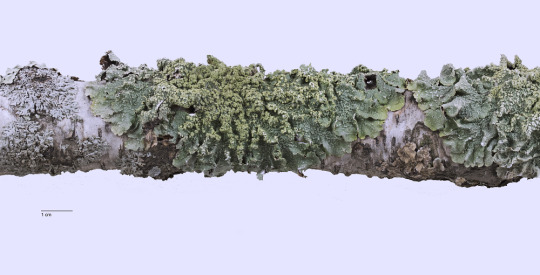
It grows on trees such as aspen, poplar and birch and occurs across southern Canada. It is most widespread in Canada in Alberta and Saskatchewan.
Fun fact: When you touch a bit of bleach to the cottony fungal threads inside the lichen, you’ll get a pink chemical reaction, making this species great for novice lichenologists to try their hand at using chemistry for lichen identification.
Why should it be Alberta’s Provincial lichen? Its beauty, its ability to inhabit and brighten up urban parks, and its distribution across Alberta where it is limited in most other regions of Canada.
Nominated by: Darcie Thauvette, Lichenologist
#2
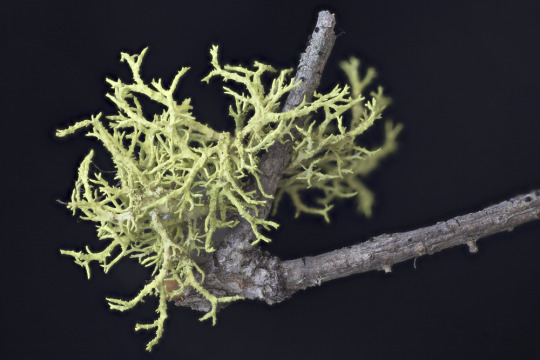
Letharia lupina
Common Name: Mountain Wolf Lichen
Wolf lichens (Letharia species) are bright yellow tufts that are hard to miss, especially in winter against a backdrop of snow. Wolf lichen is now understood to be two species, and, in Alberta, we have the more common Letharia lupina, whereas L. vulpina occurs further west and south. Mountain Wolf Lichen is tufted with rough branches covered in patches of grainy powder (called soredia, made of fungal threads and algae).
Mountain Wolf Lichen is an iconic montane species in Alberta, growing most abundantly in the Rocky Mountains, and Foothills. Rarely it also can be found in the southern Parkland and Grassland natural regions. It is most abundant on spruce and pine in conifer-dominated forests.
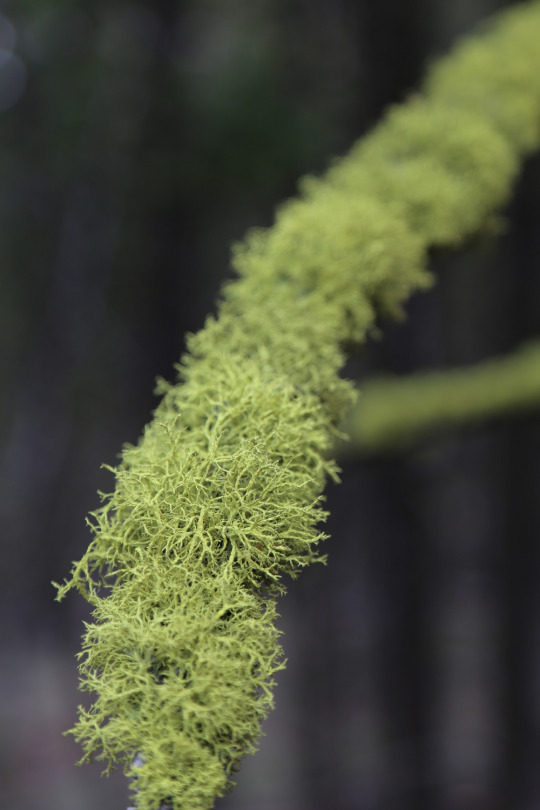
Fun fact: Or not so fun in this case. You know the old saying, don’t eat yellow….lichen!? The bright yellow colour of Wolf Lichen is from a chemical the lichen makes called vulpinic acid. This acid is poisonous. In part of Northern Europe this lichen was mixed with fat and glass shards and placed with bait to kill wolves. ‘Lupus’ is Latin for ‘wolf’. Extra extra! Scientists at the University of Alberta recently showed that Wolf Lichens are made of a team of not 1, not 2, but 3 types of fungi!
Why should it be Alberta’s Provincial lichen? Its colour and beauty, its association with the world-renowned mountains of Alberta, its limited range in most other parts of Canada, and finally its complexity - because we’re a complex and diverse province.
Nominated by Peter Josty, Executive Director, The Centre for Innovation Studies, and Mari Decker, Senior Vegetation Ecologist
#3
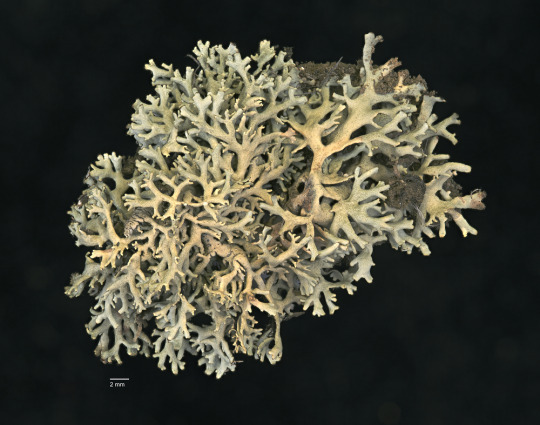
Xanthoparmelia camtschadalis
Common Name: Vagabond Rockfrog Lichen
Vagabond Rockfrog is perhaps the most charismatic and elegant of Alberta’s Xanthoparmelia. Vagabond Rockfrog typically is toonie sized, forming larger colonies when the site is right. Its lobes are slender and evenly branching; its colour is pale greenish yellow with white mottling, almost as if it was sponge-painted with watery, white paint. Keep your eyes on the ground in a prairie or well-managed pasture, and you’ll usually find this lovely lichen loosely attached to soil or resting on top of Prairie Selaginella (Selaginella densa) and Pixie-cup lichens (Cladonia spp.).
Vagabond Rockfrog Lichen is most common in the Grassland natural region but also can be found in the Rocky Mountain region. In Canada it appears to be most common in our province, with additional collections from Saskatchewan or more rarely British Columbia.
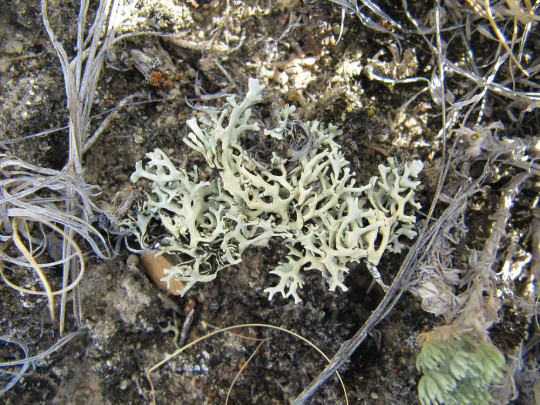
Fun fact: This lichen got its Latin name from the region it was first described from, Kamchatka, Russia. It is part of a living soil crust community that fixes carbon and nitrogen from the air, stabilizes soil, helps absorb water, and perhaps even forms a barrier to some invasive weeds.
Why should it be Alberta’s Provincial lichen? Its beauty, its association with the historically and economically important grasslands of Alberta (Alberta beef anyone?), and its limited range in other parts of Canada. Most Albertans live and work in the natural regions that historically supported prairie and aspen forest mosaics, the Grassland and Parkland. Provincially, native grassland has declined, which has also reduced quality habitat for grassland lichens. Grassland lichens are under-appreciated and under-studied - choosing a grassland ambassador could raise awareness.
Nominated by Lysandra Pyle, Rangeland Ecologist
#4

Melanelixia albertana
Common Name: Powdered Camouflage Lichen
First described from Alberta 50 years ago, Melanelixia albertana shares our province’s name. Melanelixia albertana is not in-your-face, and tends to camouflage with its olive-green color. Look on deciduous tree bark, especially poplar trees, for a leafy lichen 4 to 10 cm wide with rounded lobes and little white powdery ‘lips’ (called soralia). The skin of Powdered Camouflage Lichen is often shiny, almost oily, in appearance.
Powdered Camouflage Lichen is found in every natural region of Alberta, most commonly in the Boreal and Parkland. But don’t worry about going far to get a look; Melanelixia albertana can be spotted in urban centres, including Edmonton’s river valley. Within Canada, Melanelixia albertana is limited to the west with most collections found in Alberta, Saskatchewan, and Manitoba. Definitely, something to brag about to your friends out east!
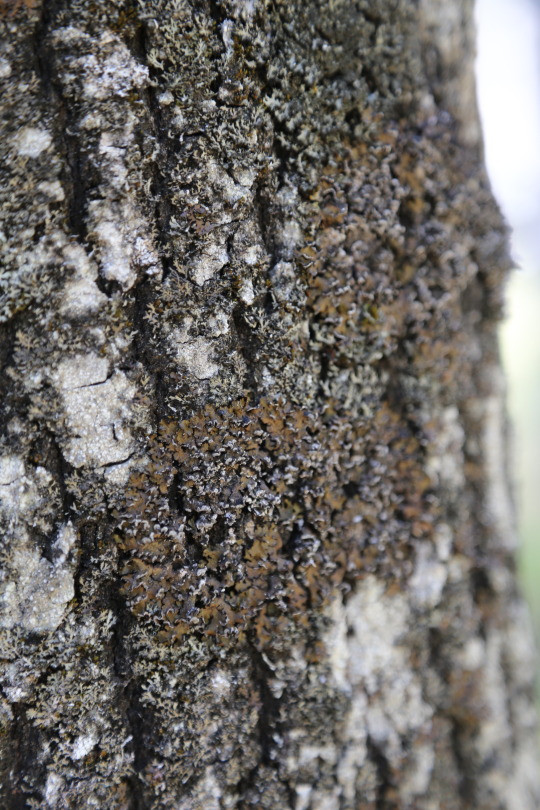
Why should it be Alberta’s Provincial lichen? Ok – it’s not yellow. But beauty is in the eye of the beholder, right! This species is named for Alberta, and current data suggests it is more abundant in Alberta than anywhere else in the world. The ‘smelly Melies’ are typically a genus of hard-to-identify brown leaf-like lichens. But Powdered Camouflage Lichen makes it easy (sort of) with its lip-shaped soralia - just like Alberta, it is unique amongst its compatriots. And finally, there’s that oily sheen – need we say more?
Nominated by Laura Hjartarson, BSc, and Derek Johnson, Botanist & Forest Ecologist
#5
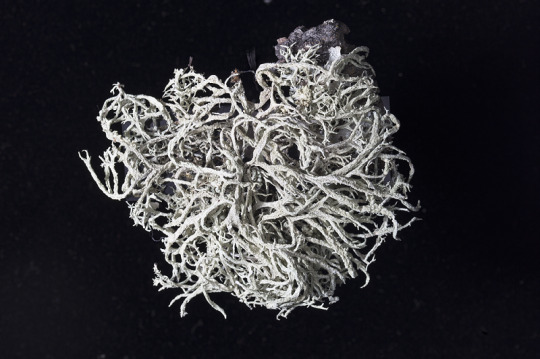
Evernia mesomorpha
Common Name: Boreal Oakmoss Lichen
Picture Einstein’s hair – only greener and thicker - that’s Boreal Oakmoss Lichen. Pale greenish-yellow, tufted and shrubby species, this lichen is found on trees of all sorts in sunny forests throughout Alberta.
Boreal Oakmoss occurs in every natural region of Alberta, most commonly in the Boreal and Foothills forested regions. However, it is a hardy species and will pop up in the grasslands on soil, rocks and fence posts.
Fun fact: This lichen has a long history of human use, particularly in Europe where thousands of tons of Evernia are collected and ground up as a perfume fixative (while it is abundant here, it’s not abundant enough to do that in Alberta!). It is also tolerant of people, and while most shrubby lichens struggle in the city, Boreal Oakmoss Lichen can be found in Alberta’s urban river valley parks.
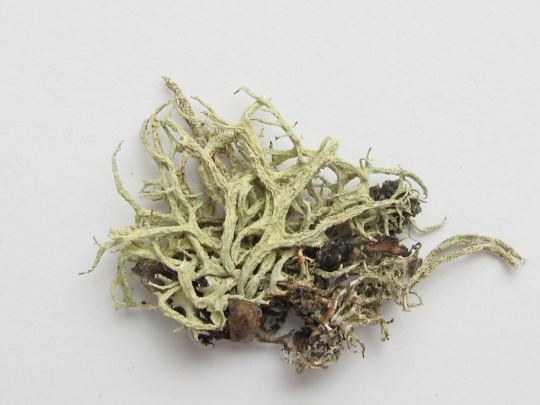
Why should it be Alberta’s Provincial lichen? This is a hardy northern species (like Albertans) that thrives across much of Canada. However, it prefers Alberta to British Columbia and its range is mostly restricted to east of the Rocky Mountains.
Nominated by Sandra Davis, Botanist
#6
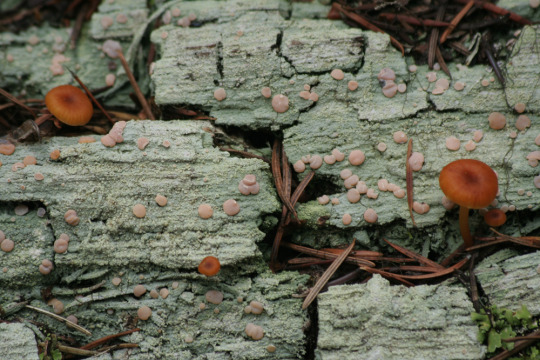
Icmadophila ericetorum
Common Name: Spray Paint Lichen
Spray Paint Lichen is aptly named – it’s easily recognized as a splash of mint green dotted with pink ‘buttons’ (actually the spore-bearing structures, called apothecia, of the lichen). Spray Paint Lichen is a crust lichen, that is, its ‘body’ is limited to a thin layer of algae and hyphae growing intimately attached to whatever it is growing on.
Spray Paint Lichen grows on damp moss, rotted wood and soil, and can be found in every natural region of Alberta. It is most common in the mountains and bogs of northern Alberta.
Fun fact: This lichen has a few common names, including Candy Dot and (ahem) Fairy Puke. No matter what you call it, this lichen is a showstopper.
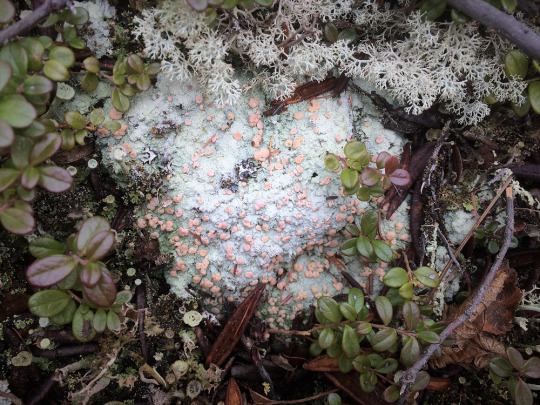
Why should it be Alberta’s Provincial lichen? This is a fun, charismatic crustose lichen that is easy to identify and occurs across much of Alberta. It also draws attention to two of our iconic environments, the Rocky Mountains, and the bogs of northern Alberta that play a critical role in water retention and filtration. It is also the only species of the genus found in North America.
Nominated by Derek Johnson, Botanist & Forest Ecologist, and Diane Haughland, Lichenologist
Pretty cool huh?
Update: Jan 29, 2019 - Voting closed on January 27th, but keep an eye on our Facebook ( http://bit.ly/2RYRTH6 ) page for an announcement of the winner!
2 notes
·
View notes
Photo

Icmadophila ericetorum is a crustose lichen that creates small pink fruiting bodies called apothecia. Since most lichens are a symbiotic relationship between an ascomycete fungus and algae, these fruiting bodies are just ascocarps; they produce and distribute spores.
108 notes
·
View notes
Photo
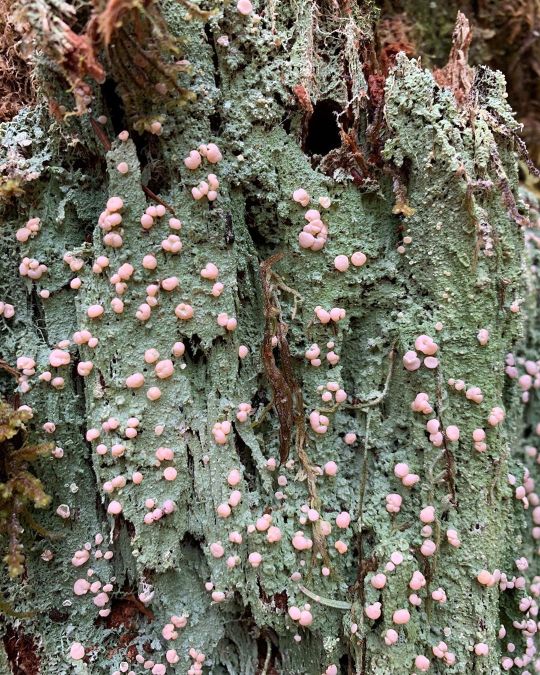
Icmadophila ericetorum. Candy crust lichen. Not a fungus, but still a favorite.⠀ ⠀ #icmadophila #icmadophilaericetorum #candycrustlichen #bubblegumlichen #candylichen #pink #pinklichen #notafungus #colorcontrast #lichen #forestfloor #forestlife #pnwphotography #lichenphotography #lichensofinstagram #pnwlichens #research #ecology #forest_captures #westcoast #💕⠀ (at Washington) https://www.instagram.com/p/B7hEp80pmYV/?igshid=16a5u99ggpshr
#icmadophila#icmadophilaericetorum#candycrustlichen#bubblegumlichen#candylichen#pink#pinklichen#notafungus#colorcontrast#lichen#forestfloor#forestlife#pnwphotography#lichenphotography#lichensofinstagram#pnwlichens#research#ecology#forest_captures#westcoast#💕
0 notes
Text



Icmadophila ericetorum, my beloved
Reply to this post with your favorite thing you've seen in nature in the past year!
62 notes
·
View notes
Text

0 notes
Photo

Bubblegum Lichen (Icmadophila ericetorum) is one of my favorite lichens to photograph. I always find it on the sides of dead conifer stumps. It has the most fantastic texture and color. The name is pretty great too.
#Bubblegum Lichen#Icmadophila ericetorum#lichen#fungus#fungi#mushroom#moss#decay#forest#biology#original#photographers on tumblr#Oregon
13 notes
·
View notes
Note
in 2019 the Royal Alberta museum ran a facebook campaign to fill the over looked slot for Alberta's Provincial lichen here in Canada!
the winner by a landslide was Spray paint lichen/ Fairy Puke; Icmadophila ericetorum

You can see the RAMS post about the contest and the winner announcement
God you don’t even know how incredibly happy this makes me. And of course Alberta would have a provincial lichen! I don’t know if there’s a lichen out there with more common names than I. ericetorum--definitely not any with more fun common names. Spray paint lichen is new to me, and I love it.
35 notes
·
View notes
Text

#icmadophila ericetorum#icmadophila#lichen#wallace falls state park#snohomish county#washington#olympus om 5
0 notes
Note
Congrats on submitting your thesis!
I specialised in phycology during grad school, so a couple of ... more scientific questions.
1. Which was the oddest algal partner in lichens you have come across? I know that Trebouxia is the most common one, but there are exceptions
2. Which is the coolest lichen specimen/species you've seen in person?
Can I cheat a little? My lab is investigating Sticta canariensis, which is pretty amazing in that it can form a symbiotic relationship with either a cyanobacteria OR a green algae, and this completely changes its physiology.

The green lobes have partnered with a green algae, and the blue-gray lobes are partnered with a cyanobacteria! Amazing, right?


I know this doesn't exactly answer your question, but this is just the coolest thing to be about lichen photobionts! This is both the oddest patnership I've seen, and the coolest lichen I've seen in person (in tiny small samples from the herbarium.
But as for cool algae, I think trentepohlia algae is amazing.

source
And favorite lichen I have seen in the wild is probably Icmadophila ericetorum




69 notes
·
View notes